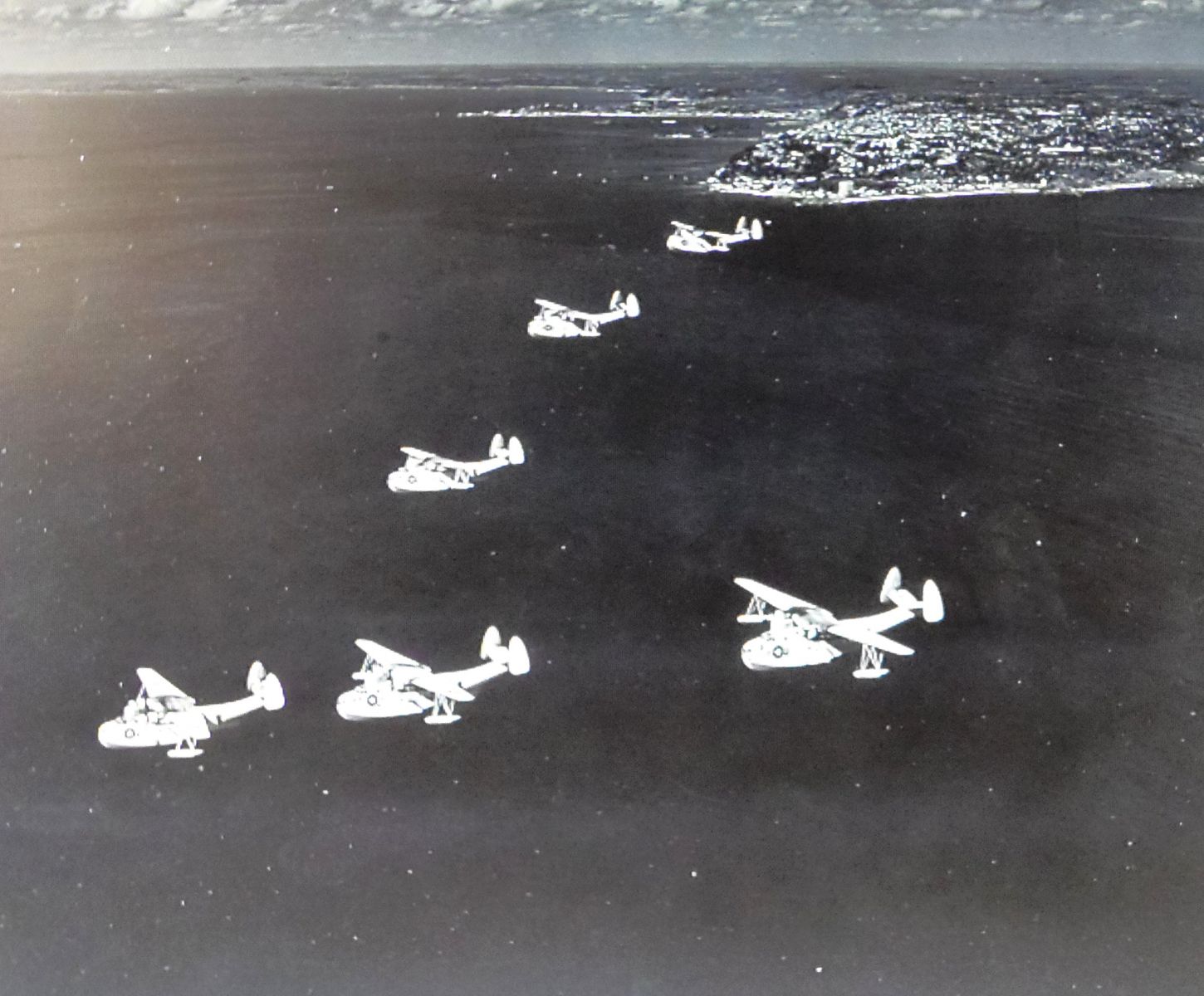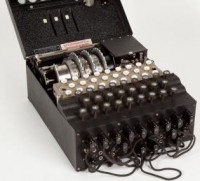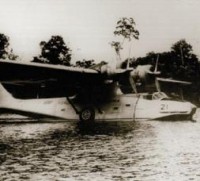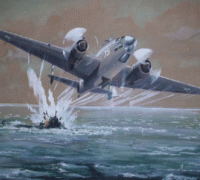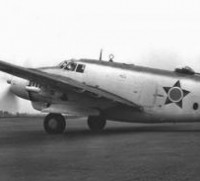ANTI SUBMARINE WARFARE SOUTH ATLANTIC * - ANTI SUBMARINE TACTICS
10)PBM MARTIN MARINER
PBM MARTIN MARINER
The Martin PBM Mariner was an American patrol bomber flying boat of World War II and the early Cold War era. It was designed to complement the Consolidated PBY Catalina and PB2Y Coronado in service. A total of 1,366 were built, with the first example flying on 18 February 1939 and the type entering service in September 1940.
Design and development.
In 1937 the Glenn L. Martin Company designed a new twin-engined flying boat, the Model 162, to succeed its earlier Martin P3M and complement the PBY Catalina and PB2Y Coronado. It received an order for a single prototype XPBM-1 on 30 June 1937. This was followed by an initial production order for 21 PBM-1 aircraft on 28 December 1937.
To test the PBM's layout, Martin built a ⅜ scale flying model, the Martin 162A Tadpole Clipper with a crew of one and powered by a single 120 hp (89 kW) Chevrolet engine; this was flown in December 1937. The first genuine PBM, the XPBM-1, flew on 18 February 1939.
The aircraft had multiple gun positions including single mounts at each midship beam and stern above the tail cone. Additional guns were positioned in the nose and dorsal turrets, each fitted with two-gun turrets. The bomb bays were in the engine nacelles. The gull wing was of cantilever design, and featured clean aerodynamics with an unbraced twin tail. The PBM-1 was equipped with retractable wing landing floats that were hinged outboard, with single-strut supported floats that retracted inwards to rest beneath the wing, with the floats' keels just outboard of each of the engine nacelles. The PBM-3 had fixed floats, and the fuselage was three feet longer than that of the PBM-1.
Operational history
The first PBM-1s entered service with Patrol Squadron Fifty-Five (VP-55) of the United States Navy on 1 September 1940. Prior to the USA's entry into World War II, PBMs were used (together with PBYs) to carry out Neutrality Patrols in the Atlantic, including operations from Iceland. Following Japan's attack on Pearl Harbor, PBMs were used on anti-submarine patrols, sinking their first German U-boat, U-158, on 30 June 1942. PBMs were responsible, wholly or in part, for sinking a total of ten U-boats during World War II. PBMs were also heavily used in the Pacific War, operating from bases at Saipan, Okinawa, Iwo Jima, and the South West Pacific.
The United States Coast Guard acquired 27 Martin PBM-3 aircraft during the first half of 1943. In late 1944, the service acquired 41 PBM-5 models and more were delivered in the latter half of 1945. Ten were still in service in 1955, although all were gone from the active Coast Guard inventory by 1958 (when the last example was released from CGAS San Diego and returned to the U.S. Navy). These flying boats became the backbone of the long-range aerial search and rescue efforts of the Coast Guard in the early post-war years until supplanted by the P5M Marlin and the HU-16 Albatross in the mid-1950s.
PBM’s continued in service with the U.S. Navy following the end of World War II, flying long patrol missions during the Korean War. It continued in front line use until replaced by its successor, the P5M Marlin, with the last USN squadron equipped with the PBM, Patrol Squadron Fifty (VP-50), retiring them in July 1956.
The British Royal Air Force acquired 32 Mariners, but they were not used operationally, with some returned to the United States Navy. A further 12 PBM-3Rs were transferred to the Royal Australian Air Force for transporting troops and cargo. The Royal Netherlands Navy acquired 17 PBM-5A Mariners at the end of 1955 for service in Netherlands New Guinea. The PBM-5A was an amphibian with retractable landing gear. The engines were 2,100 hp (1,600 kW) Pratt & Whitney R-2800-34. After a series of crashes, the Dutch withdrew their remaining aircraft from use in December 1959.
Variants.
PBM-1 (Model 162) Initial production version. 5× .50 inch (12.7 mm) machine guns. Two R-2600-6 engines; 21 built.
XPBM-2 (Model 162) Conversion of one PBM-1 as experimental catapult-launched long-range strategic bomber.
XPBM-1 (Model 162) Prototype. Powered by two 1,600 hp (1,194 kW) R-2600-6 engines.
PBM-3 (Model 162B) Improved version. 1,700 hp (1,270 kW) R-2600-12 engines; 32 built.
PBM-3R (Model 162B) Unarmed transpoar in radome behind cockpit; 274 built.
PBM-3B (Model 162C) Designation for ex-RAF Mrt version of PBM-3. 18 new build plus 31 converted from PBM-3.
PBM-3C (Model 162C) Improved patrol version with twin .50 in machine guns in nose and dorsal turrets, and single guns in tail turret and waist positions. AN/APS-15 radariner GR.1A after return to U.S. Navy.
PBM-3S (Model 162C) Dedicated anti-submarine aircraft with reduced armament (2× fixed 0.50 in machine guns in nose, single machine gun in port waist position, and single gun in tail turret) and increased range; 94 built as new plus 62 conversions.
PBM-3D (Model 162D) Patrol bomber with increased power (two 1,900 hp (1,417 kW) R-2600-22s) and increased armament (twin 0.50 in machine guns in nose, dorsal, and tail turrets, plus two waist guns). 259 built.
PBM-4 (Model 162E) Proposed version with two 2,700 hp (2,015 kW) Wright R-3350 engines; unbuilt.
PBM-5 (Model 162F) Version with 2,100 hp (1,566 kW) Pratt & Whitney R-2800 engines; 628 built.
PBM-5E Variant of PBM-5 with improved radar.
PBM-5S Lightened anti-submarine variant of PBM-5.
PBM-5S2 Improved anti-submarine aircraft with revised radar installation.
PBM-5A (Model 162G) Amphibian version of PBM-5, with retractabletricycle undercarriage; 36 built plus four conversions.
Mariner I British designation for 32 PBM-3B supplied to the Royal Air Force.
Specifications:
General characteristics
- Crew: Seven
- Length: 79 ft 10 in (23.50 m
- Wingspan: 118 ft 0 in (36 m)
- Height: 27 ft 6 in (5.33 m)
- Wing area: 1,408 ft² (131 m²)
- Empty weight: 33,175 lb (15,048 kg)
- Loaded weight: 56,000 lb (25,425 kg)
-
Powerplant: 2 × Wright R-2600-6 14-cylinder radial engines, 1,600 hp (1,194 kW) each
Performance
- Maximum speed: 178 kn (205 mph, 330 km/h)
- Range: 2,600 nmi (3,000 mi, 4,800 km)
- Service ceiling: 19,800 ft (6,040 m)
-
Rate of climb: 800 ft/min (4.1 m/s
Armament 2 Browning machine guns (two each in nose, dorsal and tail turrets, one each in blisters amidships)
Bombs: 4,000 lb (1,800 kg) of bombs or depth charges or 2 × Mark 13 torpedoes
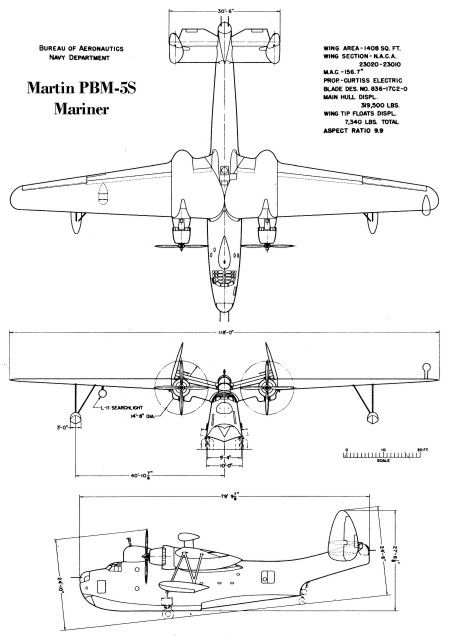
PBM SQUADRON 211 IN BRAZIL
27 September 1943: VP-211 received orders to deploy to NAF Aratu, Bahia, Brazil. The squadron's last section of four aircraft arrived at Aratu on 16 October and relieved VP-74, coming under the operational control of FAW-16. VP-211 became a part of Task Force 44, an integral part of the Fourth Fleet. A detachment of six aircraft was maintained at Governor's Island, NAF Galeão, Rio de Janeiro, Brazil, due to the distance of Aratu from the “slot” where U-boat hunting was so abundant. The slot was the area where the U-boats traversed the Atlantic from north to south via a regular route. On 12 November the squadron shifted its headquarters to Galeão for a three-month period, leaving a three-aircraft detachment at Aratu. NAF Galeão, while nearer to the hunting area, had primitive living conditions and frequently was shrouded in early morning fog. The squadron's first searchlight mission was conducted in February, and from that time on, nearly all of the squadron's patrols were conducted at night.
January 1944: The squadron's 14 to 16 hour patrols began to take their toll on the aircraft. Maintenance facilities in the area were very basic, so engine changes were made at sea off Florianópolis, Brazil. Engine changes were made in four sections of three aircraft each, with one Mariner undergoing the change, while the second stood by to assist in the maintenance, with the third hauling supplies, gasoline, personnel and food.
12 January 1944: The squadron suffered its first operational loss during a training exercise when Ensign Thomas E. Donahue and crew P-8 dropped a depth charge from too low an altitude. The munitions exploded near the tail, causing the plane to crash and burn. Crew P-4 landed immediately and rescued five critically injured survivors from the water.
10 June 1944: VP-211 was relocated to NAF Natal, Brazil, the equal of Galeao in terms of primitive living conditions. In addition, the operating area of the seaplane base at NAF Parnamirim Field was located on the Potengy River 18 miles (29 km) down river from the crews’ quarters. The primary duties while at this location consisted of barrier sweeps, which were plots predicated on the relative movement of German submarines conducted at distances approximately 800 miles (1,300 km) from base.
28 September 1944: Crew P-4 located a surfaced U-boat by radar and was driven off by the heavy anti-aircraft fire before an attack could be made. An accurate fix on the location of the submarine was made, and on 29 September two VB-107 aircraft flown by Lieutenants E. A. Krug and J. T. Burton made a coordinated attack on U-863. The U-boat was found in the same vicinity as the sighting made by VP-211 on the previous day. The sinking was confirmed by postwar review of enemy records.
29 September 1944: VP-211 was reduced in size from 12 aircraft to 9; these aircraft and personnel were sent to join VPB-98 at NAS Corpus Christi, Texas. 21 November 1944: The squadron's second operational loss occurred when Lieutenant Robert H. Lind and crew P-2, while on patrol between Natal and Aratu, encountered a violent thunderstorm and crashed into the sea, losing all hands.
January 1945: VPB-211 was temporarily based aboard USS Matagorda at Bahia Bay to assist in the training of the ship's crew in handling seaplanes at advanced bases.
February 1945: VPB-211 was temporarily based aboard USS Rehoboth at Bahia Bay to assist in the training of the ship's crew in handling seaplanes at advanced bases.
1–31 March 1945: The squadron was temporarily based aboard USS Rockaway for advanced base training.
April 1945: VPB-211 was based aboard USS Humboldt at Bahia Bay to assist in the training of the ship's crew in handling seaplanes at advanced bases.
16 May 1945: Convoy patrols were discontinued. On 24 May orders were received to turn over the squadron's aircraft to HEDRON-11 at NS San Juan, Puerto Rico, and proceed to NAS Norfolk for disestablishment.
14 Jun 1945: VPB-211 was disestablished at NAS Norfolk
By https://en.wikipedia.org/wiki/Martin_PBM_Mariner
Magnificent view of several PBM upon departure from Aratu heading eastward for another patrol mission. Photo by Charles Ives. http://www.nww2m.com/category/featured-artifacts/page/10/
Below an archival footage on the inception and deployment of the flying boats which had important role in fighting the enemies at the seas.
